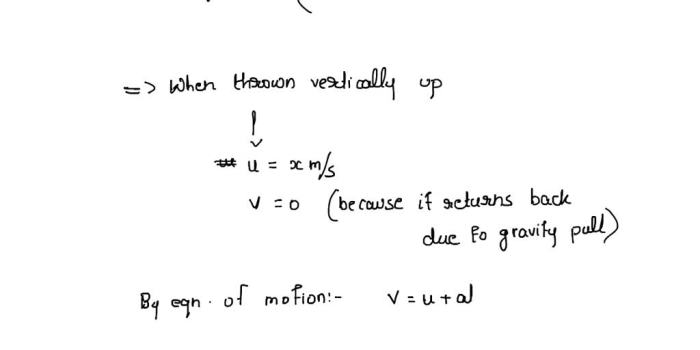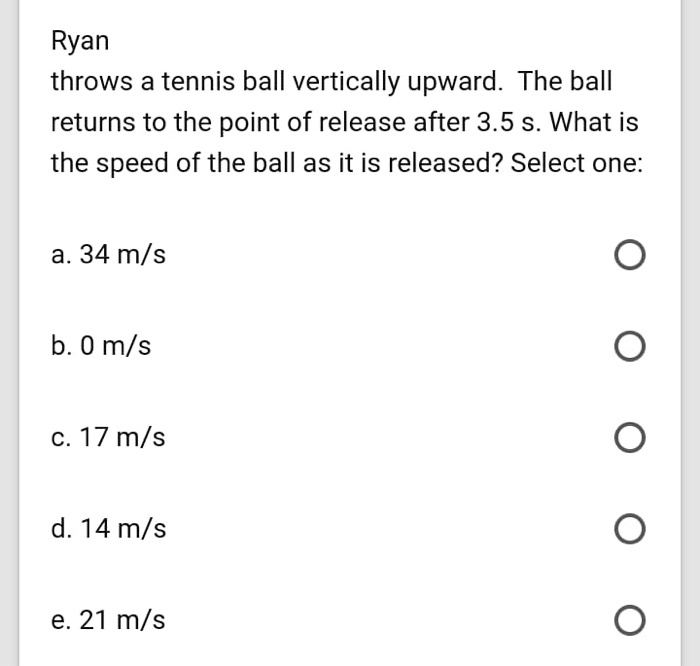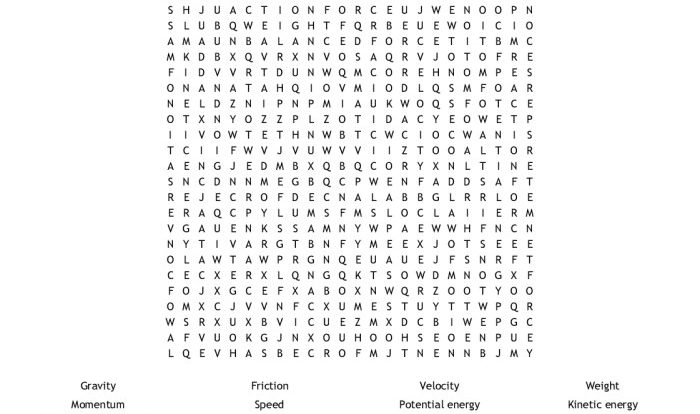Ryan throws a tennis ball vertically upward – In the realm of physics, the motion of objects is a captivating subject, and the act of throwing a tennis ball vertically upward serves as an intriguing example. This action initiates a series of events governed by fundamental physical principles, providing insights into concepts such as initial velocity, acceleration due to gravity, and displacement.
As the ball embarks on its upward trajectory, it traces a parabolic path, reaching a maximum height before commencing its descent. Throughout this journey, its velocity undergoes constant change, and the interplay between kinetic and potential energy becomes evident.
Delving deeper into the physics of this seemingly simple act reveals a wealth of knowledge. The initial velocity imparted to the ball determines the height it will reach, while the acceleration due to gravity governs its downward motion. The time spent in the air, known as the time of flight, can be precisely calculated, and the effects of air resistance and spin on the ball’s trajectory and velocity can be analyzed.
Physics Principles

The upward motion of a tennis ball is governed by fundamental physics principles. As the ball leaves Ryan’s hand, it possesses an initial velocity (v i) that determines its initial upward speed. The ball’s motion is then influenced by the acceleration due to gravity (g), which causes it to decelerate at a rate of 9.8 m/s 2.
As the ball rises, its velocity decreases until it reaches its maximum height, where its velocity becomes zero. The ball then begins to descend, accelerating downward due to gravity. The displacement (Δy) of the ball is the vertical distance it travels from its initial position.
Trajectory and Velocity, Ryan throws a tennis ball vertically upward
The trajectory of the ball during its upward motion is a parabola. The maximum height (h) reached by the ball can be calculated using the formula:
h = (vi2) / (2g)
The velocity (v) of the ball at different points in its trajectory can be calculated using the formula:
v = vi
gt
where t is the time elapsed since the ball was thrown.
Time of Flight
The total time (t f) the ball spends in the air is the sum of the time it takes to reach its maximum height and the time it takes to descend back to the ground. The time to reach maximum height can be calculated using the formula:
tup= v i/ g
and the time to descend back to the ground can be calculated using the same formula. Therefore, the total time of flight is:
tf= 2
vi/ g
Energy Transformations
During the ball’s motion, there is a conversion of kinetic energy to potential energy and vice versa. As the ball rises, its kinetic energy (due to its motion) is converted into potential energy (due to its height above the ground).
At its maximum height, the ball’s kinetic energy is zero and its potential energy is at its maximum.
As the ball descends, its potential energy is converted back into kinetic energy. At the moment it hits the ground, its potential energy is zero and its kinetic energy is at its maximum.
Air Resistance and Spin
Air resistance is a force that opposes the motion of the ball through the air. It causes the ball to decelerate and reach a lower maximum height than it would in a vacuum. The effects of air resistance are more pronounced for slower-moving balls.
Spin can also influence the trajectory and velocity of the ball. Backspin causes the ball to curve downward, while topspin causes it to curve upward. Spin can also affect the ball’s stability and bounce.
FAQ Guide: Ryan Throws A Tennis Ball Vertically Upward
What is the maximum height reached by the ball?
The maximum height reached by the ball depends on its initial velocity and the acceleration due to gravity. It can be calculated using the formula: h = (v^2) / (2g), where h is the maximum height, v is the initial velocity, and g is the acceleration due to gravity (approximately 9.8 m/s^2).
How does air resistance affect the ball’s motion?
Air resistance acts as a force that opposes the motion of the ball. It causes the ball to decelerate as it moves through the air, reducing its maximum height and velocity.
What is the relationship between the initial velocity and the time of flight?
The initial velocity of the ball directly affects the time of flight. A higher initial velocity results in a longer time of flight, as the ball takes more time to reach its maximum height and return to the ground.



